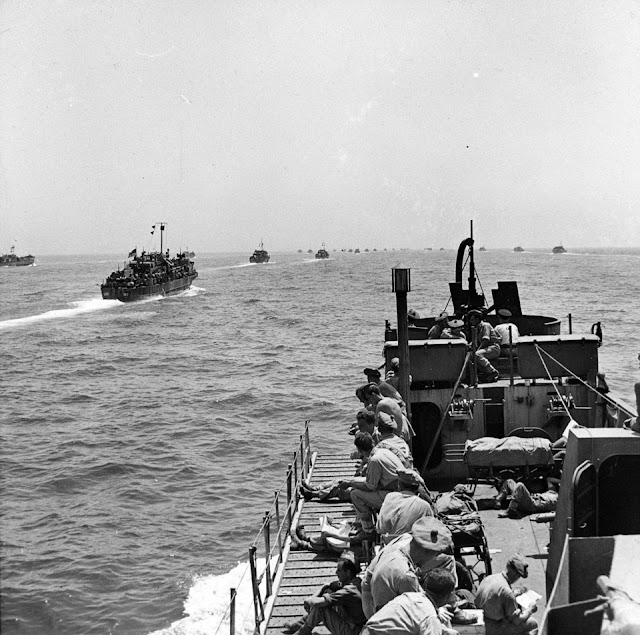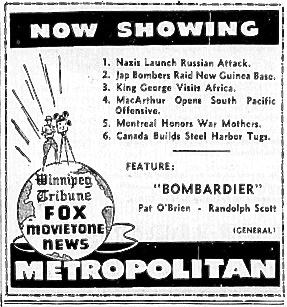Local Tars and Canadians in
Combined Operations in Sicily
Introduction: It doesn't happen often that I see historic pictures of landing craft and mention of Canadian Navy volunteers (e.g., RCNVR) in Combined Operations on the same day. But on July 14, 1943, the photo below appeared in The Winnipeg Tribune along with a couple of stories closely linked to the few hundred Canadians (along with hundreds of British and American sailors) who operated and maintained a variety of landing crafts, e.g., ALCs (landing craft, assault) and LCMs (landing craft, mechanized) during Operation HUSKY.
Below is a clearer photo with a similar vantage point upon an LCI(L), landing craft, infantry (large) I believe:

Caption: Landing craft of the Sicily invasion armada setting sail, July 1943.
"The Allied invasion of Sicily, codenamed Operation Husky, began on 9 July 1943,
ended on 17 August. At the time it was the largest amphibious operation of the war.
Photo Credit and Details - National Army Museum
Mr. Hunter mentions Combined Operations units above, in his opening paragraph, then adds more details that pertain to the Canadians in Combined Ops, in part:
There were no casualties in the two R.C.N. flotillas which have returned to port, an R.C.N. spokesman announced today. Other flotillas have not returned.
Some of the Canadian seamen ferried in British troops who were part of the first wave of the invasion forces to move onto beaches in the southeastern corner of Sicily.
[Editor: The 55th and 61st flotillas of assault landing craft (ALCs) deposited troops ashore in Sicily, and when finished that task returned to home base, likely in North Africa, perhaps Alexandria. The 80th and 81st flotillas of landing craft mechanized (LCMs) stayed in Sicily for 3 - 4 weeks, e.g., some near Avola, well into the first week or two of August, 1943.]
Hunter adds:
Dieppe Veterans
The majority of the Canadian seamen were veterans of the Dieppe and North African landings last summer and autumn and were perfectly trained for their task. They came from all parts of Canada.
Besides the complete Royal Canadian Navy flotillas there were many Canadians serving in Royal Navy units. They were included in the 500 total.
The first picture of the part the stalwart sons of the Dominion played was brought back from Sicily by Lt. Cmdr. E.H. Bartlett, R.C.N., of Toronto, Press Relations Officer who was ashore briefly on Sicily.
The Canadian sailors were not perturbed when they were briefed for the landings a few days before the assault. But when told that Canadian soldiers would be part of the invasion force they "were simply delighted."
[Editor: Lt. Cmdr. E.H. Bartlett later became a POW, accidentally! Link to more information here concerning his fate.]
Typical Story
The story of Petty Officer E.H. Randall, of Halifax, shows how well trained these Canadians were. Although his assault craft was not under fire a heavy sea was running when a line fouled the propeller, forcing him to drop behind.
In the darkness he attempted to clear the stern but realized he would not be able to, so he decided to continue with one engine and by skilful manoeuvring was in the exact position he was supposed to be at the proper time.
Some assault craft brought back the wounded to the ships offshore.
Bartlett said the morale of the men was "tremendous". Before the landing operation started, he went below decks to see what the men were doing and counted seven keen card games in one mess.
Right On Shore
The Canadian seamen were dressed and ready to go ashore. They were a motley crew, in khaki or blue jerseys with grey flannels. Each wore the inevitable tin hat and carried emergency rations. They sipped cocoa, coffee, ate cheese, as they prepared for the landing. The traditional tot of navy rum was absent.
The first landing craft encountered some brisk opposition but the troops wiped out machine-gun nests and other opposition. The naval bombardment facilitated the later movements of the troops ashore.
The naval craft delivered the fighting men right up on shore where the water was no more than ankle deep. The troops spoke in muffled tones as they moved ashore. One muttered, almost under his breath, "Now bring on those bloody Italians."
Some Names
There were a few cases of seasickness. One man expressed the ardent wish (that) "we would have this invasion in a place where we could get over bridges."
Here are the names of some of the Canadians in the naval end of the landings:
From Manitoba: Stoker G. V. Franklin, 618 Walker St., Winnipeg: Shipwright E. T. Healis, 353 Baltimore Rd., Winnipeg: AB. R. O. Preston, Minnedosa.
* * * * *
The article introduced by the above headline was written by Scott Young, Canadian Press Staff Writer at the time. Mr. Young, a former R.C.N. Lieutenant, and sports columnist for the Toronto Globe and Mail, and father of musicians Neil and Astrid Young, not only writes about Air Force and Navy "slanguage" as seen below, but, with one other writer, produced the text for Gilbert A. Milne's excellent book H.M.C.S. (One photographer's impressions of the Royal Canadian Navy in World War II).
Mr. Young writes:
LONDON, July 14 - A cruise through notebooks accumulated during visits to various air stations and naval establishments, plus research with the army men and war correspondents, show conclusively that the Royal Canadian Air Force and navy are running a dead heat for the championship usage of slanguage, with the Canadian forces with the army running a poor third.
One of the best army terms is "glass house" - meaning jail, a bit of slang with just as much quality as anything any of the other services have produced. But for quantity go to the fliers and sailors.
"Spot of Biz"
The air force and navy combine quite a few slang terms. Possibly this is because of the liaison Fleet Air Arm. Both refer to all things walking, flying or swimming as "types" - good or bad.
A navy stoker may tell you that he is extremely "nattered" by it all and is going immediately to "flake" himself out for a "spot of biz." Translated that means that he is bored and is going to lie down and sleep.
He may have been "bottled" (bawled out) for doing the same thing before but he knows the "Jimmie" (first lieutenant) and his buffer (petty officer who carried out officers' orders) are both ashore so he is safe.
In navy "slops" are stories, "hang upon" means correct and "beat up" means a party. A mid-shipman is a "snottie," a sub-lieutenant is "subbie" and when a buffer carries out an officer's order, he is "tying on the can."
"Worse Than Prang"
The air force word for a bawling out is to have his "strip torn off." Anything free is "gash," and to be bored may be to the "sound up." A nailbender is an unqualified tradesman. "Urk" is a ground crewman. "Prangadang" is worse than to "prang" which is to crack-up.
Four Canadian veterans of Combined Ops, including a "Gash"
L - R: Stoker E. Brown, Leading Seaman Coxswain D. Harrison,
"Subbie" R. McRae (background), and AB "Gash" Bailey.
"Gash" got the nickname by regularly asking for leftover deserts.
In all three of the services "Pukka Gen" is information and "guff gen" is a wrong steer or misinformation. The army uses "pugged" for anything tough, "dummy up" for shut up, "armored cow" for canned milk, and "Joe" for anyone in the ranks instead of "type." Joe has replaced entirely the words guy, fellow and chap.
Even the best of terms may be archaic in a matter of months. Witness the decline of the terms "good show" and "good go" in the army, and "good do" in the navy for proof of that.
* * * * *
The article introduced by the headline above contained the following details, in part:
This hard-hitting Empire force, under Gen. Sir Bernard Montgomery, is meeting only weak enemy resistance, it was announced....
While fleets of (Allied) bombers and fighters swept the island from end to end and combed surrounding waters to lay down a fiery blockade, a motor torpedo boat flotilla made a rapier thrust at the jugular vein of Sicilian supply and penetrated Messina strait, the two-mile neck of water between the island and mainland. There three enemy motor torpedo boats were engaged Monday night, and two of them set afire and driven ashore.
* * * * *
A lengthy interview with "Monty" by John Gunther, North American Newspaper Alliance war correspondent and radio commentator, revealed a good deal about "his ideas on warfare."
A few lines are offered below:
I asked the General what his feeling about the war was just now and he replied the main thing to say was that the whole tenor of the war had changed because the Germans were now on the defensive....
"We are calling the tune now, not they," he asserted.
"What lessons learned from the African battle can be applied to future campaigns?" I asked.
Gen. Montgomery replied: "First, concentrate your forces: second, knit your ground and air forces together. That's it. Knit ground and air together absolutely."
* * * * *
Caption with photos directly above and below: Allied troops storm ashore on Sicily in these two pictures, first to be received on this Continent of the invasion. (Above), a U.S. tank, pennants flying, plunges off a landing craft to hit the beach in the first moments of the attack. (Below), a group of invasion barges comes to the island's shore to disgorge its loads of fighting men and material on the coast. - (A.P. Wirephoto via U.S. Army Signal Corps Radiophoto from Algiers.)
FYI - A copy of the top photo is for sale on ebay.
* * * * *
Please find below one other headline and a few ads from The Winnipeg Tribune, July 14, 1943:




















No comments:
Post a Comment